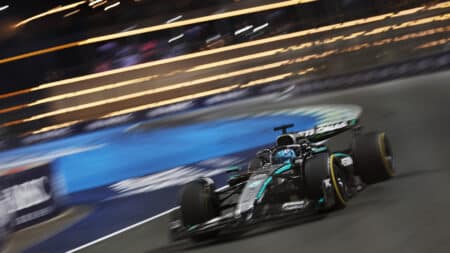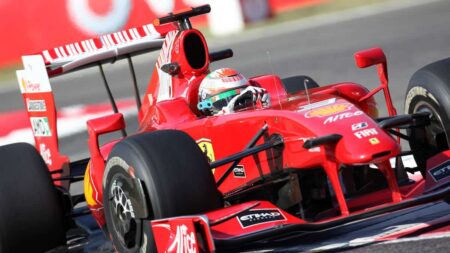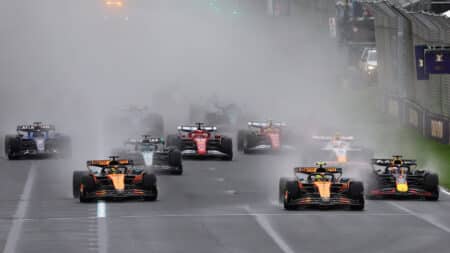Thoroughness is an adjective associated (affiliated?) with Mercedes-Benz. Twice its Silver Arrows have redefined the sport’s gold standard in terms of attention to detail and strategic thinking, structures, models and methods, and high-tech and high-achievement.

Victories on debut, in 1934 and ’54, caused quivers that can still be felt. That’s why the company was able to steer clear of Grand Prix racing, as a constructor, for so long. Jobs thoroughly done.
It’s been seeking to match that since its 2010 return. At Sepang on Sunday, this was achieved, and the weight of history was lifted from its shoulders.
Lewis Hamilton, too, appeared reborn. His speed has never been in doubt – and that was part of the problem. Formula 1 is at a strange place and finally its fastest driver has dealt with that.
His victory was stupendously thorough rather than joyously spectacular, yet he hopped from his ‘bubble’ to bubble about W05 being the best car he has driven.

The best, I’m guessing, since the McLaren he hurled about when the pressure was on the other guy.
Now he can turn his back – in a good way – on those carefree days. Now he is again able to roll with F1 rather than fight it.
If Nico Rosberg is to beat his team-mate to the world title, he will have to outsmart him. Malaysia, therefore, will have provided him with much food for thought. And some of it might prove unpalatable so tasty did Hamilton look.
How Mercedes-Benz handles its charges will be its next big challenge.
Mercedes’ original return
It had no such problem in 1955. New signing Stirling Moss held team leader Juan Fangio in such esteem that he was content to play second fiddle in the GPs. At Spa and Zandvoort, he sat in the master’s wheel tracks, happy to learn sure in the knowledge that Fangio could pull away should he choose to.
Moss’s season at Mercedes-Benz sharpened his organisation and concentration. So complete was the team, so reliable were its cars that he felt a pressure to deliver from without as well as within.

This was amplified by the W196’s quirks. He never came to love it like he did the balletic Maserati 250F. Its controls were heavy in comparison and its gear-change pattern was counterintuitive.
It demanded intense respect.
What Moss liked most about this unlovely (in its open-wheel guise at least) car that emitted an unusual noise (from its straight-eight with desmodromic valve actuation) was its competitiveness.
The latter, however, was not a given despite what M-B’s reputation implies.
Its 1954 comeback, with all its geopolitical sensitivities, was laden with expectation – more so than 2010s – and Mercedes-Benz could not afford to disappoint. Its sensational return, at Reims in July, was meticulously stage-managed, from its selection of a track ideally suited to its streamliner’s strengths to the 1-2 photo finish between Fangio and Karl Kling.

Elsewhere, the unwieldy W196 – in both body forms – won chiefly because Fangio was at its wheel. And even he required much luck to win the Italian GP at Monza.
So Mercedes-Benz pulled out all the stops for 1955. From the moment Moss stepped from the car at a wintry test at bleak Hockenheim, to be greeted by an immaculate mechanic proffering a bowl of hot water, soap, clean flannel and a fresh towel, he knew that he was unlikely to experience the like ever again.
Nothing was too much trouble.
Three different lengths of chassis, plus a new option of outboard front brakes, generated a bewildering variety when combined with the extant body shapes. The competitions/experimental department needed every one of its 200 designers, engineers, fabricators and mechanics to keep on top of it, while constructing 14 chassis and building 70 engines.

This, remember, for just 14 races spread over two seasons.
It’s no surprise that it didn’t always go to plan.
Monza ’55
After a three-day test, with six drivers evaluating a host of wheelbase/body/brake specs, it was decided that the medium streamliner coped best with the demands of Monza’s new banking. Two more were created forthwith.
Yet a fortnight later, with some of the track’s bumps having been eased, it was discovered during practice that the long version was now the better choice. And M-B had only one of them on site.
In the space of 30 hours it dispatched a pair 100mph transporters to collect two such cars, being feverishly built at Stuttgart, and returned them to Monza.
And this, remember, was despite Fangio and Moss being already assured of first and second position in the championship, and the company having already made its decision to withdraw from F1 after this very race.

Though the situation wasn’t ideal, M-B was going out with a flourish. It had eight cars at Monza.
Each of its four drivers plumped for/were allocated different specs of machinery, yet still they locked out the three-car front row and ran 1-2-3-4 in the race’s early stages.
This sequence was broken when a stone shattered Moss’s screen. He wasn’t at all surprised that his crew had a spare ready for him, or that they fitted it with alacrity, but he was taken aback when a piston collapsed not long after he had set the fastest lap.
Kling, too, retired – because of a broken transmission – but Fangio cruised to victory in his long streamliner, with team-mate Piero Taruffi, in a short open-wheeler, less than a second behind. Yet more stage management – albeit with a hint of pantomime.

Much has changed in the 59 years between these 1-2s, but there can be no doubt that last week’s was achieved in the more competitive environment.
Mercedes-Benz is once again resetting the sport’s gold standard and, as it does so, Hamilton, as did Moss, is honing different skills while shining brightly and radiating contentment and confidence in the glare of the Three-Pointed Star.
More from Paul Fearnley
Schumacher at his sporting best
Keke and Nico’s Australian GP wins
Jacky Ickx’s final flourish in Formula 1
Follow Paul on Twitter












